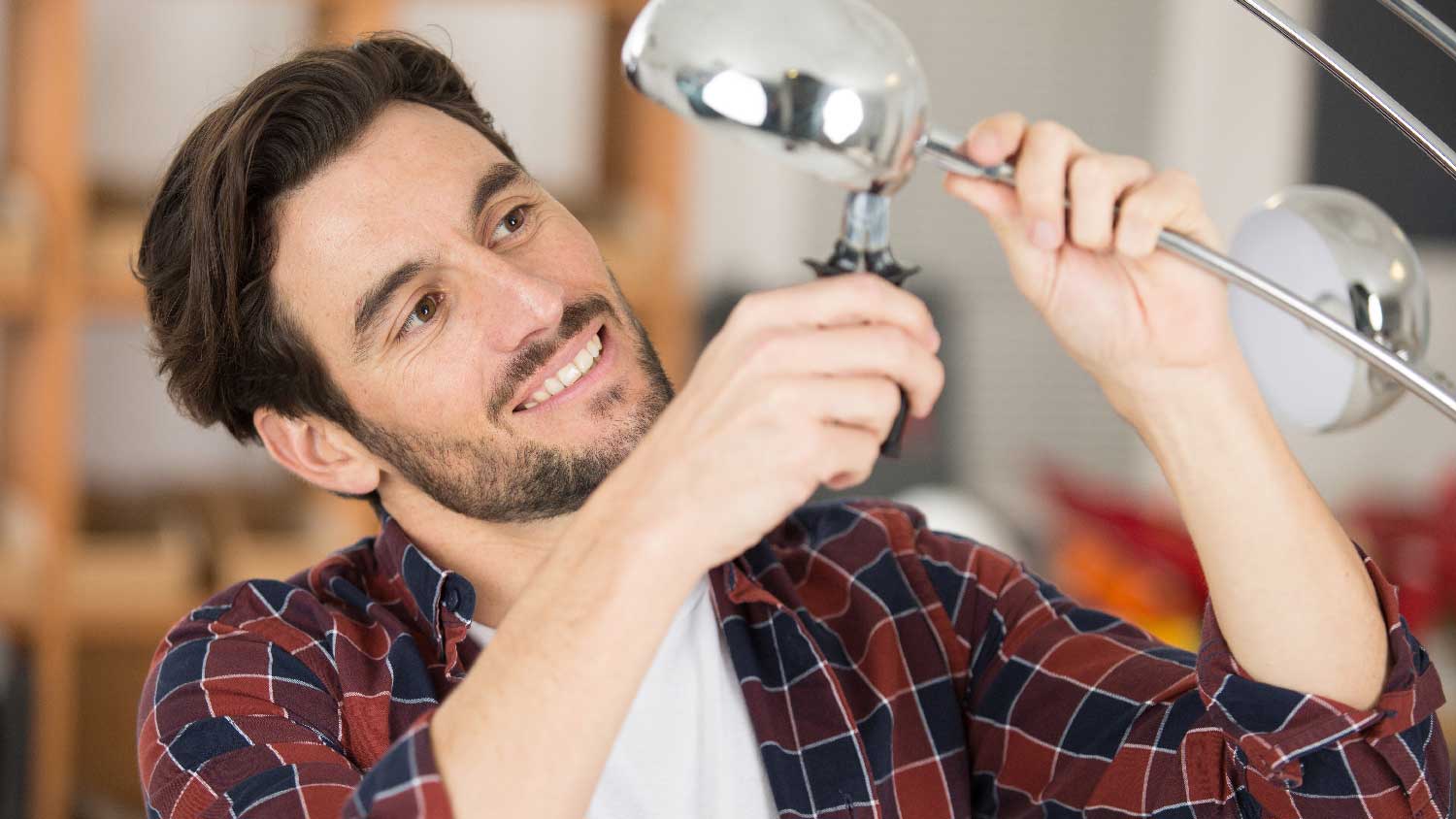
Get transparent light fixture repair cost info. Learn what impacts price, compare repair vs. replacement, and find ways to save.
Say goodbye to your unlit friend


Removing a broken light bulb isn’t dangerous, but call a light fixture pro if you’re worried about getting cut or shocked or don’t know how to shut your power off.
Call a lighting pro to remove light bulbs in difficult-to-reach areas.
A pro can more easily remove traditional-style incandescent bulbs with a smaller base that can be tricky to remove on your own.
Light bulbs are delicate by nature, so it shouldn’t come as a surprise that they sometimes break. Whether it’s kids rough-housing at home, a miscalculation while moving some furniture, or simply getting a little overzealous while trying to unscrew a burnt-out bulb, it’s inevitable that you’ll deal with a broken bulb at some point. In this guide, we’ll explain a few methods for how to remove a broken lightbulb safely and easily.
First things first, what kind of bulb are you dealing with? Many newer types of light bulbs (e.g., fluorescent and LED lights) come with a larger metal base, making it easier to simply unscrew the bulb without much risk. However, if you’ve broken a more traditional style bulb (such as an incandescent or halogen bulb), you’ll probably be dealing with one of the smaller (and harder to remove) types of light bulb base sizes. This might make the job of removing it a little trickier.
Once you’ve figured out which kind of bulb you’re dealing with (and whether it’s as simple as turning off the switch and unscrewing it by hand), you’ll need to make a few preparations to remove it safely.
Bulbs use electric currents to light up, which can be very dangerous when the internals of the bulb are exposed after it breaks. Before you get anywhere near touching the lightbulb, shut off the power to the fixture entirely. Don’t solely rely on simply turning off the switch—some lights are controlled by multiple switches, and it’s better to be safe than sorry. The current flowing from these fixtures can be quite strong, potentially turning a quick DIY task into an emergency.
If you’ve got a broken bulb in an external lamp, make sure it’s unplugged. If it’s wired into your home with a fixture, be certain to flip the appropriate switches (or remove the fuse entirely) at your power breaker. We also recommend double-checking that the power is off at the broken bulb using a circuit tester.
You’re dealing with strong electric current and broken glass, after all, so it’s wise to protect yourself with some basic equipment. The main ones to consider are rubberized gloves to stop current from entering your body via your hands. These will also help protect your hands from broken glass. We also recommend wearing eye protection in case the glass splinters or breaks during removal.
It’s a good idea to remove the bits of broken glass from the bulb base before trying to remove it. Using gloved hands or pliers (and making sure the power is turned off), carefully snap off any glass shards and dispose of them safely.
Depending on the method you end up using to remove your broken bulb, you’ll only need a few of these tools to get the job done. Here are all the tools that you can use to safely remove a broken light bulb:
Sturdy trash bag to dispose of the broken bulb
Needle-nosed pliers, ideally with rubber handles
Broken bulb extractor
Quick-setting epoxy or a hot glue gun
Wooden dowel about the width of your bulb’s base
A large potato (yes, really)
A small paring knife

Once you’ve safely switched off power to your broken lightbulb and have gathered your tools and safety gear, it’s time to remove that pesky bulb and replace it. Here are five proven methods to do it:
If you have a pair of needle-nosed pliers at home, this should probably be the first option you try.
With the power confirmed off and your gloves and eye protection on, simply grab the base of the filament (the thin, metal coils inside the bulb) with your pliers.
Squeezing as hard as you can, gently twist the pliers counterclockwise.
Hopefully, the base will unscrew, and you’ll be able to pull out the broken bulb quite easily.
If the filaments of the bulb are broken (either from the initial break or while you were trying the above method), you might still be able to extract the bulb with your trusty pliers.
Insert the pliers straight into the base of the bulb and open them as wide as possible, essentially grabbing the base from the inside.
Wrap the tips of your pliers with a little electrical tape to help with grip.
Using both hands to keep the pliers open, turn them counterclockwise to unscrew the base and remove the broken bulb.
If you don’t have pliers or have a broken bulb in a hard-to-reach spot, try this simple method with a few basic crafting tools.
Find a wooden dowel or stick that is flat on the end and about the same diameter as the bulb base.
Cover the end in hot glue or quick-setting epoxy and squash it against the bulb base, applying firm pressure.
Hold it there until the adhesive has set, and then try gently twisting the stick counterclockwise to release the bulb.
If you want to buy a purpose-built tool for this task, you can get a light bulb extractor for as little as $10 from the hardware store. It uses a rubber tip to grab onto the bulb’s base and provide enough friction to unscrew it. Plus, most can be easily screwed onto an extension pole, making them ideal for lights in high fixtures.
No tools? No problem—just grab a potato. This starchy staple might actually be your saving grace when it comes to removing a broken lightbulb. If your broken bulb has filaments, glass, or other parts jutting out, all you need to do is:
Cut a humble, uncooked potato in half.
Push it into the bulb base, and gently twist it while applying pressure.
If your bulb’s base is smooth, you can still use the potato method, just a little differently.
Using a paring knife, you’ll need to carve one end of the potato into a cylinder small enough to fit inside of the base, but large enough to grab onto it from the inside.
You might also have to carve a few spaces to make room for other parts of your lightbulb.
Then, simply insert the carved end of your potato and rotate counterclockwise while applying pressure to unscrew the bulb base.

Light bulbs are delicate, and it’s sometimes unavoidable to break one. But there are a few things to keep in mind to help you avoid the tricky task of removing broken light bulbs:
Switch from fragile incandescent bulbs to sturdier fluorescent or LED bulbs
Be careful when unscrewing an intact light bulb—too strong of a grip and you might break it
Don’t force stuck light bulbs
Don’t over-turn light bulbs when installing them
Always handle light bulbs carefully and store them in a rigid container
Make sure bulbs are cool before handling—hot ones break more easily
From average costs to expert advice, get all the answers you need to get your job done.

Get transparent light fixture repair cost info. Learn what impacts price, compare repair vs. replacement, and find ways to save.

Discover the average wall sconce installation cost, key price factors, and ways to save on your lighting project. Get transparent, expert-backed cost info.

Discover the professional Christmas light installation cost, including average prices, cost factors, and tips to save on your holiday lighting project.

Learn how much a light costs a year, so you can learn how to calculate the annual price for light fixtures and decide on the right bulbs for your home.

The right lighting can make a big difference when it comes to your home. Learn about the different types of light fixtures and their pros and cons.

There are several different types of recessed lighting that vary in style and functionality. Use this guide to find the best recessed option for your home.